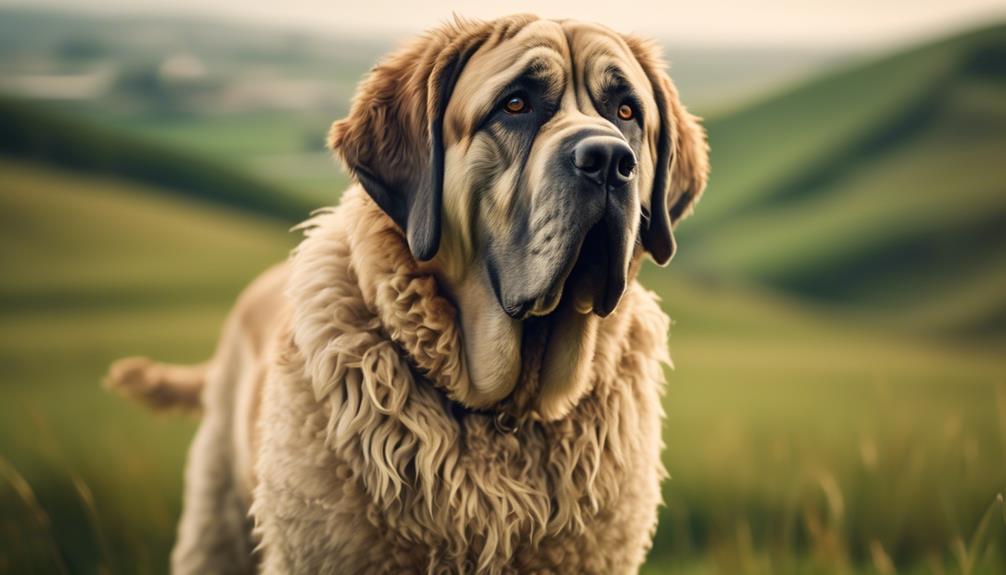
The Spanish Mastiff, a formidable and majestic breed, has captured the hearts of many dog enthusiasts with its impressive size and gentle demeanor. Take, for example, the case of a family in need of a loyal and protective companion. As they embark on their search for the perfect canine addition to their home, they stumble upon the Spanish Mastiff and are immediately captivated by its regal appearance and reputation as a devoted guardian.
But what other characteristics and information make this breed truly unique? What are its exercise and grooming needs? How does it interact with children and other pets? In this discussion, we will delve into the world of the Spanish Mastiff, exploring its history, temperament, and suitability as a family pet, leaving you wanting to discover more about this remarkable breed.
Key Takeaways
- The Spanish Mastiff is one of the largest dog breeds, with males weighing 140-175 pounds and females weighing 110-130 pounds.
- They have a calm and gentle temperament, but can be stubborn and independent, requiring experienced training and socialization.
- They have relatively low energy levels and are suited to apartment living, as long as their exercise needs are met.
- Spanish Mastiffs are known for their impressive size and weight, and are popular as guard dogs while also being gentle and loving family pets.
Size and Weight
The Spanish Mastiff is a giant breed known for its impressive size and weight. Males of this breed typically stand between 27-30 inches tall and weigh 140-175 pounds, while females are slightly smaller, measuring 26-28 inches in height and weighing 110-130 pounds. Their large size makes them one of the largest dog breeds in the world.
Despite their imposing stature, Spanish Mastiffs have a calm and gentle temperament. They’re fiercely loyal and make excellent watchdogs. However, they can be stubborn and independent, which requires experienced training and socialization.
In terms of exercise needs, Spanish Mastiffs are relatively low-energy dogs. A daily walk or two, along with access to a secure yard for running and playing, is usually sufficient.
Their thick coat sheds heavily and should be brushed at least weekly. Regular grooming is also necessary, including bathing as needed, trimming nails, and checking ears for infection.
See another Dog breed profile.
Spanish Water Dog Breed
Lifespan and Temperament
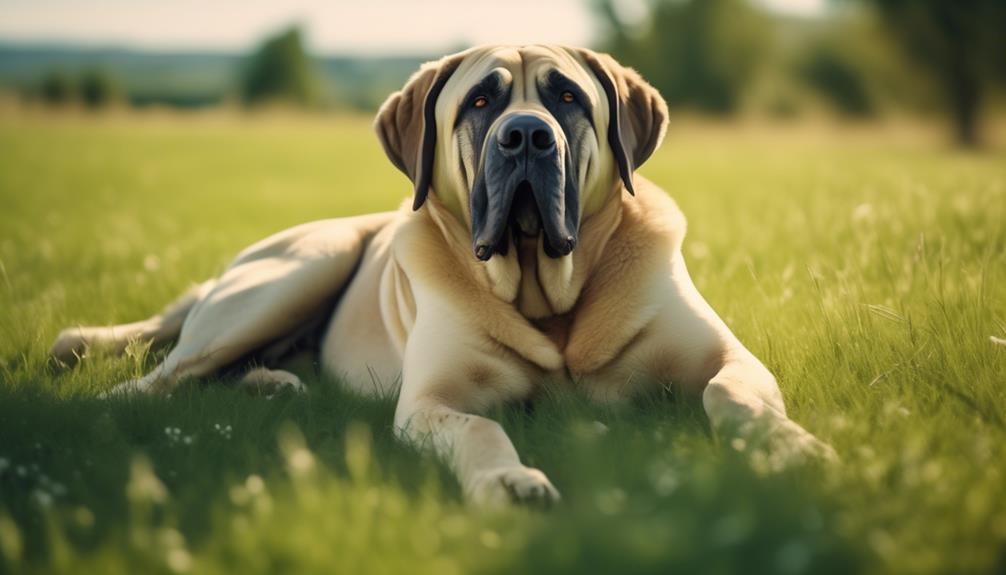
Moving on to the lifespan and temperament of the Spanish Mastiff, let’s explore their typical life expectancy and the characteristics that define their personality.
The Spanish Mastiff has a lifespan of about 10 to 12 years, which is average for a large breed.
In terms of temperament, they’re known for being calm, gentle, and fiercely loyal. They’re intelligent and protective, making them excellent watchdogs. However, they can also be stubborn and independent, so experienced training and socialization are important.
Despite their size, Spanish Mastiffs are relatively low-energy dogs and usually require only a daily walk or two. They’re known to be loving and gentle, making them suitable as family pets.
Exercise and Grooming Needs
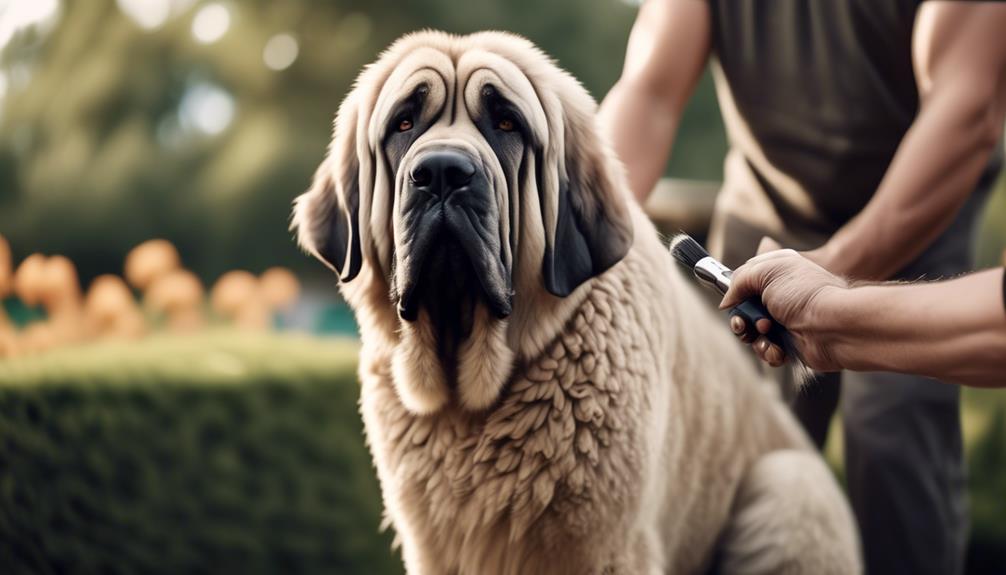
To meet the exercise and grooming needs of the Spanish Mastiff, regular physical activity and proper coat care are essential. Despite their large size, Spanish Mastiffs are relatively low-energy dogs and do not require excessive exercise. A daily walk or two, along with access to a secure yard for running and playing, is usually sufficient to keep them happy and healthy. When it comes to grooming, their thick coat requires regular brushing to prevent matting and shedding. They should be brushed at least once a week, and baths should be given as needed. Additionally, their nails should be trimmed regularly and their ears checked for infection. By providing adequate exercise and grooming, owners can ensure that their Spanish Mastiff remains in optimal health and condition.
| Exercise Needs | Grooming Needs |
|---|---|
| Regular physical activity | Regular brushing |
| Daily walks or playtime | Bathing as needed |
| Access to a secure yard | Nail trimming regularly |
| Checking ears for infection |
Adaptability and Choosing
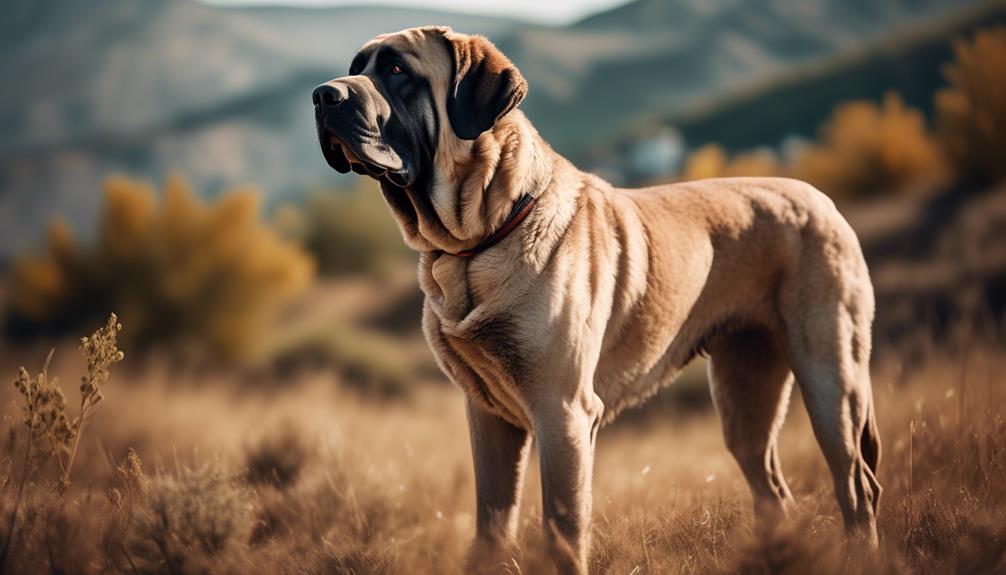
When considering the adaptability and choosing of a Spanish Mastiff, it’s important to prioritize factors such as size, energy levels, and living arrangements.
Spanish Mastiffs can adapt well to apartment living, but their large size and exercise needs should be taken into account. For apartment dwellers, it’s best to choose a dog that’s quiet, low-energy, calm indoors, and well-mannered.
Spanish Mastiffs, with their low sensitivity level, can handle a noisy and chaotic household. However, they may not be the best choice for novice owners due to their strong-willed nature.
When choosing a Spanish Mastiff, it’s recommended to prioritize adoption from rescue organizations or shelters. If buying from a breeder, it’s important to choose a reputable one who prioritizes health and temperament and provides a nurturing environment.
History and Origin

After considering the adaptability and choosing factors of a Spanish Mastiff, it’s important to delve into their history and origin.
The Spanish Mastiff, also known as the Mastín Español, has a long and rich history in Spain. They’re believed to have descended from ancient Molosser dogs brought to the Iberian Peninsula by the Phoenicians and Greeks.
For centuries, Spanish Mastiffs have been used as livestock guardians, protecting sheep and other animals from predators. They were highly valued for their size, strength, and protective instincts.
The breed’s origins can be traced back to the mountainous regions of northern Spain, where they were developed to withstand the harsh climate and rugged terrain.
Today, Spanish Mastiffs are still revered for their guardian abilities and are cherished as loyal and gentle family pets.
Barking and Famous Depiction
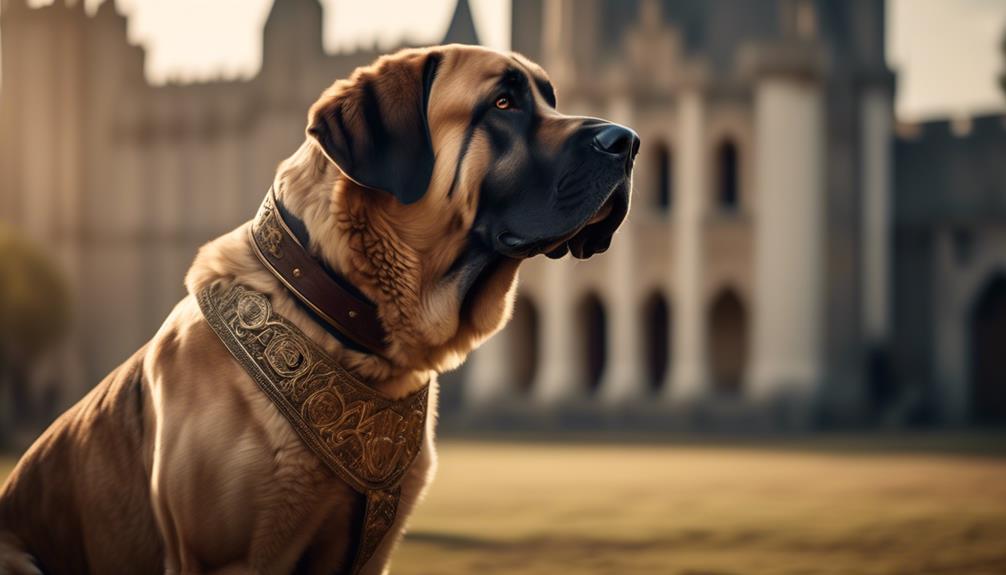
The Spanish Mastiff is known for its minimal barking and has gained recognition for its portrayal in Diego Velázquez’s painting ‘Las Meninas’.
Unlike many other breeds, the Spanish Mastiff tends to bark only when necessary, making them relatively quiet dogs. This characteristic is attributed to their calm and confident nature, which allows them to assess situations before reacting.
Their deep, booming bark, however, is quite impressive and can serve as an effective deterrent to intruders.
In addition to their reputation as guardians and protectors, Spanish Mastiffs have also made their mark in the art world. The painting ‘Las Meninas’ by Diego Velázquez prominently features a Spanish Mastiff, further highlighting their significance in Spanish culture.
Popularity and Suitability as Family Pets
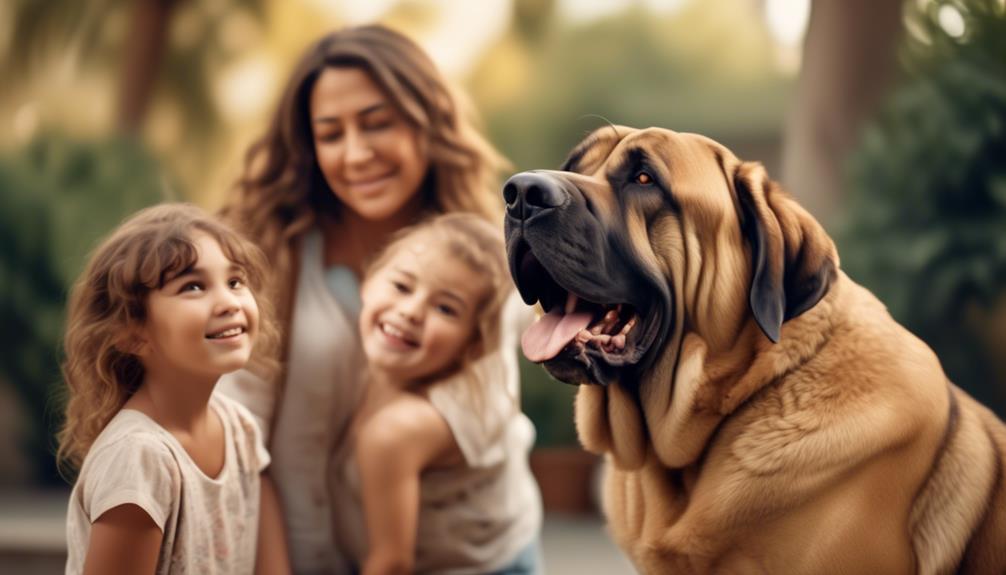
Spanish Mastiffs are increasingly gaining popularity as family pets due to their gentle and loving nature. Here are three reasons why they’re suitable for families:
- Gentle and Loving: Spanish Mastiffs have a calm and affectionate temperament, making them excellent companions for families. They form strong bonds with their owners and are known to be gentle and patient with children.
- Protective Nature: Spanish Mastiffs have a natural instinct to protect their loved ones. They’re excellent watchdogs and will fiercely guard their family and home. Their loyalty and protective nature make them a reliable and trustworthy addition to any family.
- Adaptability: Despite their large size, Spanish Mastiffs can adapt well to different living situations, including apartments. They’re relatively low-energy dogs and can be content with daily walks and access to a secure yard for exercise. Their adaptability makes them suitable for families living in various environments.
Size, Personality, Health, Care, Feeding, and Coat
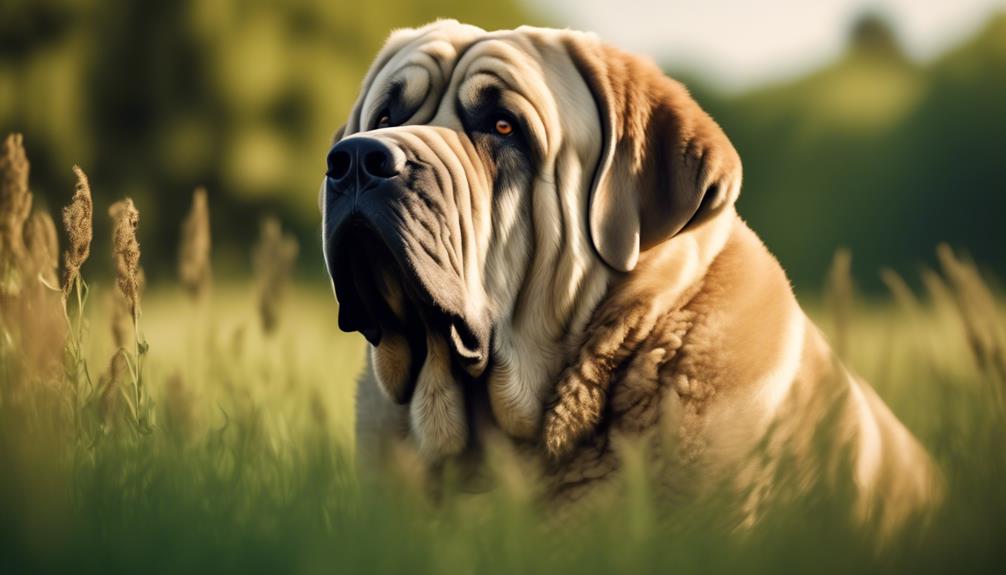
Gaining popularity as family pets, Spanish Mastiffs are known for their impressive size, gentle and loving nature, and adaptability to different living situations. Considered a giant breed, they can reach heights of 26 to 35 inches at the shoulder and weigh between 140 to 220 pounds. Despite their size, Spanish Mastiffs are described as aloof, calm, and fiercely loyal. They make excellent watchdogs and are more agile than they appear.
However, they can also be independent and stubborn, requiring experienced training and socialization. Like many large and giant breeds, they’re predisposed to health issues such as bloat, hip/knee dysplasia, entropion eye, and panosteitis. Regular veterinary checkups, maintaining a healthy weight, and proper grooming are essential for their well-being.
Their medium-length coat sheds seasonally and requires weekly brushing and occasional baths. While they form strong bonds with their family, they can be territorial and may not get along with other dogs. Proper supervision is necessary, especially during playtime with children.
Interaction With Children and Other Pets
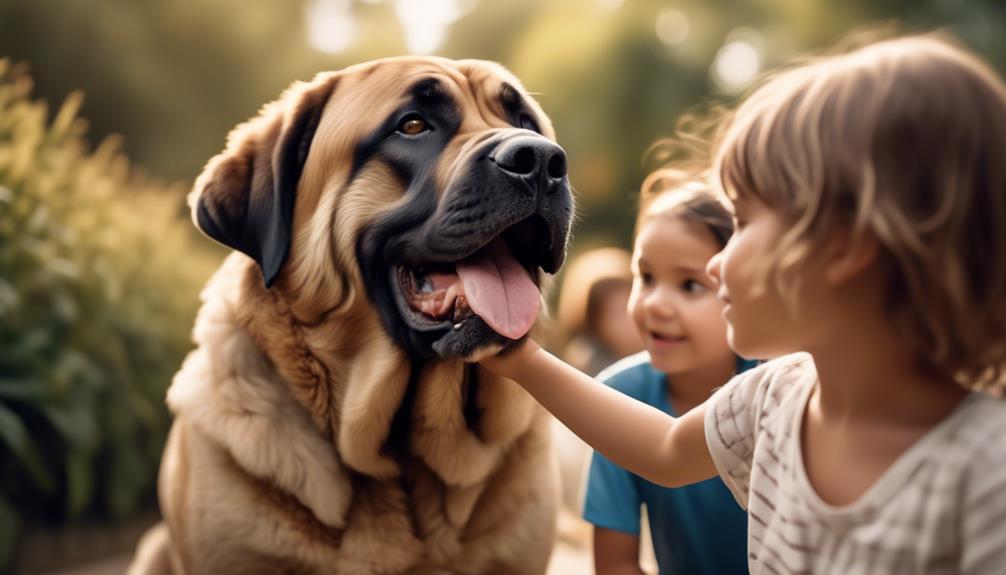
When interacting with children and other pets, Spanish Mastiffs exhibit a gentle and loving nature. They’re known for their calm and patient demeanor, making them well-suited for families with children. Here are three important things to know about their interaction with children and other pets:
- Protective instincts: Spanish Mastiffs have a strong protective instinct, which extends to the children in their family. They’ll naturally watch over and guard them, ensuring their safety.
- Socialization is key: Proper socialization from a young age is important for Spanish Mastiffs to interact well with other pets. With early and positive exposure, they can learn to coexist peacefully with cats and other dogs.
- Supervision is necessary: While Spanish Mastiffs are generally gentle, their large size and protective nature mean that supervision is necessary when they interact with other pets, especially smaller ones. This will prevent any unintentional harm and ensure a harmonious environment for everyone involved.
Rescue Groups, Breed Organizations, and Weight
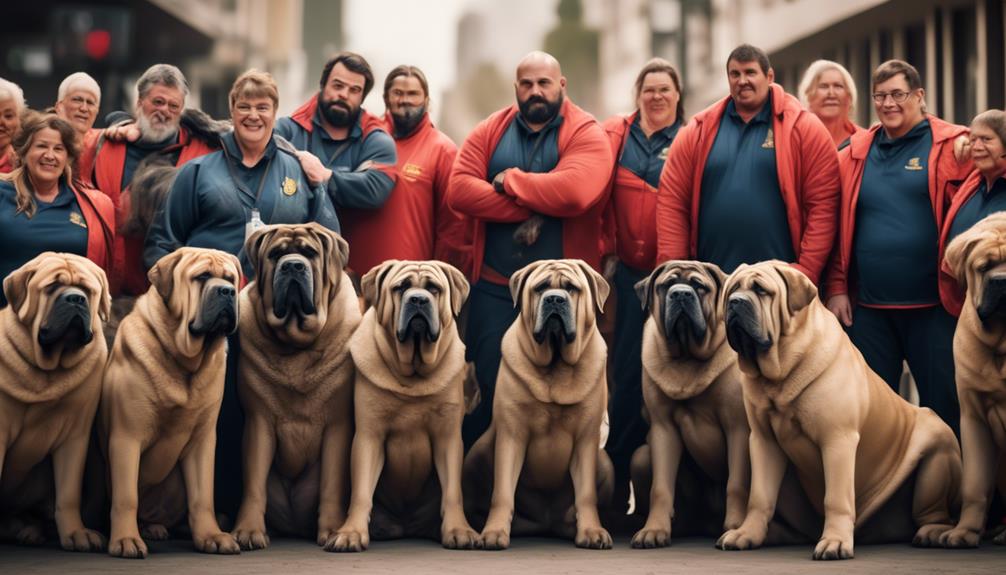
As we shift our focus to ‘Rescue Groups, Breed Organizations, and Weight’, it’s important to highlight the resources available for Spanish Mastiff enthusiasts and owners.
For those interested in adopting a Spanish Mastiff, there are several rescue groups and organizations that specialize in the breed. Some notable ones include Mastiffs To Mutts Rescue, Inc., Mastin Matters, Mastino Rescue, and the Mastiff Club of America. These groups provide a network of support, information, and resources for potential adopters.
Additionally, it’s crucial to choose a reputable breeder who prioritizes the health and temperament of the breed. They should screen breeding stock for health problems and provide lifetime support.
When it comes to weight, Spanish Mastiffs are large and heavy dogs. Adult males weigh between 140-220 pounds, while adult females weigh between 100-180 pounds. It’s important to maintain a healthy weight for these dogs to prevent potential health problems.
Frequently Asked Questions
Are Spanish Mastiffs Good With Children and Other Pets?
Spanish Mastiffs are gentle and loving, making them suitable as family pets. They form strong bonds with children and enjoy playing with them. However, they can be territorial and may not get along with other dogs or show aggression towards cats and other pets.
What Are Some Common Health Issues That Spanish Mastiffs Are Prone To?
Spanish Mastiffs are prone to common health issues in large and giant breeds, such as bloat, hip/knee dysplasia, entropion eye, and panosteitis. Regular veterinary checkups, maintaining a healthy weight, and proper grooming are essential for their well-being.
How Often Should Spanish Mastiffs Be Groomed?
Spanish Mastiffs should be groomed at least once a week. Their thick coats shed heavily, so regular brushing is necessary. They should also be bathed as needed, nails trimmed regularly, and their ears checked for infection.
What Is the Typical Lifespan of a Spanish Mastiff?
The typical lifespan of a Spanish Mastiff is 10-12 years. They are known for their calm and gentle temperament, making them suitable as family pets. However, they may require experienced training and socialization due to their independent and stubborn nature.
Can Spanish Mastiffs Adapt Well to Apartment Living?
Spanish Mastiffs may struggle with apartment living due to their large size and exercise needs. While they can adapt, it’s important to consider their calm and low-energy nature, as well as providing access to a secure yard for exercise.
Conclusion
In conclusion, the Spanish Mastiff is a large and gentle breed known for its loyalty and calm temperament. With proper training and socialization, they can make excellent watchdogs and family pets.
While they require daily exercise and grooming, their adaptability to different living situations makes them suitable for apartment living.
Whether adopted from rescue organizations or reputable breeders, the Spanish Mastiff’s size, personality, and low sensitivity level make them a wonderful addition to any household.




